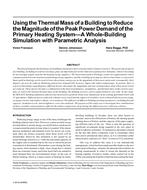
Using the Thermal Mass of a Building to Reduce the Magnitude of the Peak Power Demand of the Primary Heating System–A Whole-Building Simulation with Parametric Analysis
- Comments Off on Using the Thermal Mass of a Building to Reduce the Magnitude of the Peak Power Demand of the Primary Heating System–A Whole-Building Simulation with Parametric Analysis
- ASHRAE
The idea of using the thermal mass of a building to maintain a more constant indoor climate is not new. This particular propertyof a building, including its exterior envelope, plays an important part in the reduction of peak power demands, which is becomingan increasingly urgent issue for the heating energy suppliers. The latest smart-grid technology creates new opportunities wherecommunication between customers and heating energy suppliers, and the resulting invoicing on a shorter time-basis, is concerned.Smart-grid technology can be used to lower the primary energy use as the magnitude of the power peaks and, consequently, theirimpacts can now be reduced. Reducing peak power demand will, however, impact the indoor temperature. At present, there isa lack of knowledge regarding how different factors determine the magnitude and rate of temperature drop when power levelsare reduced. These factors include a combination of the heat transmittance, airtightness, and thermal mass of the exterior envelope,as well as the internal thermal mass of the building, the building services, and occupant behavior over time. In this study,the IDA-ICE building simulation software has been used to perform whole-year simulations of an existing apartment block with15 apartments. Different power reduction schemes were tested and the impact of variables, such as household electricity usage,occupancy levels, and outdoor climate, were analyzed. The influence of different building envelope parameters, including thermalcapacity, insulation levels, and airtightness, were also analyzed. The purpose of this study was to investigate how combinationsof these variables and parameters affected the indoor temperature drop during the different power reduction schemes.
Citation: Thermal Performance of Exterior Envelopes of Whole Buildings XIII, Conference Papers
Product Details
- Published:
- 2016
- Number of Pages:
- 8
- Units of Measure:
- Dual
- File Size:
- 1 file , 960 KB
- Product Code(s):
- D-BldgConf16-61

